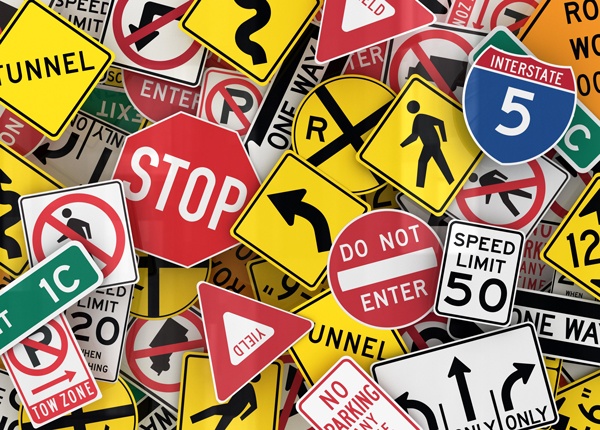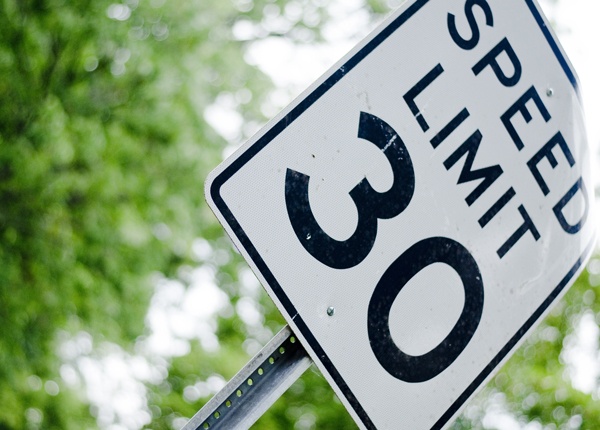
Know Your Road Signs: Traffic Signs and Their Meaning
Updated Oct. 20, 2020Most of the information you need to drive safely and legally on a roadway is conveyed by road signs. Using easily recognizable shapes, colors and symbols, road signs are designed to indicate road laws, upcoming changes in roadway layout, potential dangers and important details about location, without posing too much of a distraction to motorists.
The simplistic design of road signs makes them easy to recognize quickly – if you are familiar with common colors and shapes. Following this introduction, a series of sections covers road sign categories, shapes, colors, meanings and everything else you must learn about the subject in preparation for the permit test.
What are the different types of road signs?
To grasp the meaning of a road sign while driving your vehicle on a public road, you must first be able to identify what “type” of road sign it is. With practice, this will become second nature. There are four main categories of road sign:
- 1

Regulatory signs display the rules governing a stretch of roadway.
- 2

Warning signs inform motorists of upcoming hazards on the roadway.
- 3

Guide signs tell drivers where they are, which locations are nearby or how to reach their destination.
- 4

Construction signs highlight work zones, road closures or detours.
More information on each of these road sign categories can be found in detailed sections later in this module.
Recognizing road signs
There are hundreds of different road signs in common use on our country’s roads. Despite this, training yourself to recognize them all is not as daunting a task as you might expect. The key to understanding road signs is learning to identify them based on common themes.
Rather than memorizing hundreds of individual signs, student drivers must focus on learning the patterns which connect them. Based on the color and shape of a road sign you should be able to grasp its general meaning, even if you have never seen that road sign before.
Regulatory signs
First up, our course addresses regulatory road signs. These road signs are in place to tell drivers how they must drive in the area where the sign is posted. Regulatory signs enforce traffic laws and may refer to speed, parking rules, lane usage or right-of-way. Misunderstanding or ignoring a regulatory sign would endanger all road users in the vicinity and could earn you a fine or penalty.
In general, regulatory signs are black and white rectangles. Though, it is important to note that some of the most important regulatory signs do not fit this pattern. Find out which special signs these are, in our full exploration of the topic.
Warning signs
Warning signs tell motorists that driving on the stretch of road where the sign is posted involves greater risk. It could be that the road ahead curves unexpectedly, the pavement is slippery or there are wild animals in the area. Being aware of these dangers helps drivers to avoid accidents and collisions.
Encountering a warning sign usually means that drivers must mitigate the advertised risk by altering their speed and/or position on the road, while proceeding with caution. Most warning signs identify the nature of the risk involved, as different hazards may require different actions. Nearly all warning signs are yellow and diamond-shaped – though of course, there are exceptions. “What are warning road signs?” deals with the most common types of warning sign and their meanings.
Guide signs
Several different sub-categories of guide sign fall within this larger group. One thing is common among them all: they provide useful information about location and upcoming destinations. Guide signs offer details that may be beneficial to drivers, rather than implicit instructions that must be followed.
The type of guide sign you are dealing with will determine its color and shape. Some are designed similarly around the country, while others are state-specific. Guide signs help motorists to navigate unfamiliar routes, track their current location and identify nearby facilities, such as gas stations, rest stops and hotels. Learn how to read guide signs during this section of the course.
Construction and maintenance signs
Construction and maintenance signs mark roadway work zones and are similar in design and color to warning signs, as both convey a similar message to drivers: slow down and proceed with caution. These signs are usually orange and will not always be present on the roadway. When the construction, maintenance or utility work being conducted is complete, work zone signs will be taken down.
This type of road sign will either:
- Tell motorists how to drive around the work zone (e.g. merge or slow down).
- Warn them of a hazard present in the work area (e.g. road surface changes or hazardous materials).
Drivers must always respond appropriately to construction and maintenance zone signs. Failure to do so could result in a serious incident or incur a much higher traffic fine than usual. Read more about these issues in the full section.
Road signs by shape and color
The final section in this module serves as a quick-access guide to recognizing road signs by their shape and color. It summarizes much of the information about regulatory signs, warning signs, guide signs and construction signs previously covered, while discussing uniquely designed road signs in a little more detail.
If you want to know what a specific color or shape generally means without exploring the different categories of road sign fully, you will find what you need here. It may be useful to print this page so you can refer to it easily when you wish to brush up on your road sign knowledge.
License renewal road sign test
Some drivers may be required to pass a second road sign recognition test when renewing their license, to demonstrate that their road sign knowledge is still up-to-scratch. Whether this applies to you will depend on several factors, including:
- The driver’s license renewal procedure in your state.
- Whether your license has expired, and for how long.
- Whether you are considered a high-risk driver (e.g. older adults, people with suspended licenses).
Check an up-to-date copy of your state’s driving manual for full details on this issue. If you do need to take another road sign test or simply want to fine-tune your road sign skills, try our license renewal practice test!




